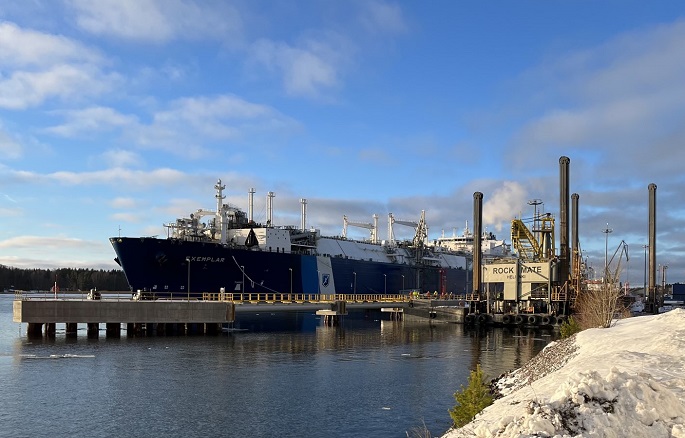Radical events in the Finnish gas market - security of supply ensured
Published : 07 Nov 2023, 10:08
It's only been four years since Finland's natural gas imports were entirely dependent on the Russian pipeline connection. At the beginning of 2020, the Balticconnector between Finland and Estonia was commissioned, and a year ago, in the conditions of energy crisis, so was the floating LNG terminal in Inkoo. In an amazingly short time, Finland has changed gas monopoly to global LNG market. After the Balticconnector pipeline breach in October 2023, the task is to secure steady deliveries of gas over the winter.
From the 1970s until the beginning of 2020, almost all methane fed into Finland's natural gas network came from Russia via the Imatra border point. The gas trade was based on very long-term contracts with the Russian export monopoly Gazprom.
The main motivation for the Balticconnector project was to create another source of supply and liberalise our national market. EU's significant support was critical for the investment decision to build pipeline between Finland and Estonia. Finland's gas monopoly was dismantled and incumbent Gasum's network operations were unbundled to be managed by Gasgrid Finland, which was established as a transmission system operator.
Both Balticconnecor and Inkoo's terminal are crucial
In the conditions of the Russian military aggression and the related energy war, Balticconnector connection has been very valuable. The Finns refused unfounded requirements for trade via ruble accounts, which is why Gazprom informed about suspension of gas deliveries on May 20, 2022. On the very same day, Gasgrid and the US company Excelerate Energy signed an agreement to lease a large LNG terminal, FSRU, to Finland.
The natural gas consumption is relatively low in Finland, but it still has important uses. The acquisition of the Inkoo FSRU was vital to secure the needs of our industry and the energy sector, as the last few weeks have also shown. The project, approved and implemented at record speed, culminated in the arrival of the Exemplar ship in Inkoo at the turn of the year 2022/2023. Since gas on the southern side of our regional market, the Baltic states, is also imported as liquefied natural gas, there has been a fast shift from long-term pipeline gas imports to short-term market-based LNG trading.
Pipe breach and ensuring gas supply over the winter
The Balticconnector pipe break on October 8, 2023 brought new challenges to the operation of the gas market. Two import routes remained for the gas imports into the Finnish grid for the winter - Inkoo and the significantly smaller LNG terminal in Hamina.
The state of our energy supply is stable, but the new situation requires special care. Since one-off cargoes to Inkoo are large, their timing and coordination is important to ensure continuous supply. Sufficient flexibility of gas supply when demand fluctuates, for example according to heating needs, must also be taken into account. The special situation will continue until the undersea gas pipeline is repaired, which will happen in April 2024 at the earliest.
LNG unloading shifts at the Inkoo terminal are distributed among competing importers by transparent principles and equally. Gasgrid’s FSRU company announced on 6 November that the slots for winter LNG cargoes have been successfully filled. This is an excellent starting point for securing winter gas supplies. Gasgrid, gas companies and various authorities ensure the continuity of supplies in many different ways.
The EU has many roles
Finland is part of the European electricity and gas internal market, which has common rules. The EU has also supported the Balticconnector and other European critical infrastructure constructions.
So far, the EU has not imposed gas import sanctions after Russia attacked Ukraine. However, in the legislation currently being negotiated, the so-called gas package, EU member states will be given the option to ban the import of Russian gas into their territory. Due to the energy crisis, the EU has also enabled voluntary joint gas purchases through the AggregateEU arrangement - Finnish buyers have not taken advantage of this so far.
There is also an obligation in the EU regulations to make a joint responsibility agreement between the member states connected by the pipeline in order to secure the security of gas supply in exceptional situations. Such an agreement is just coming into effect between Finland and Estonia - of course, it cannot be applied in practice until the gas pipeline between us is repaired.
Global markets are developing
As if reflecting the international operating environment, our gas market has therefore changed radically in a few years. Dependence on a single source of supply has changed to global sources of supply. Therefore, the price of gas in our country is affected by factors such as turns in the Chinese economy or strikes at Australian LNG terminals.
However, according to the IEA's assessment, within a couple of years, the seller's market will be transitioning to a buyer's market, when a very significant amount of new LNG export capacity in Qatar, for example, will be commissioned. So hope for a more peaceful future.
NB: The writer is the Director General of the Energy Department of the Ministry of Economic Affairs and Employment.


